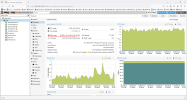Hi Proxmox Community,
I'm currently setting up a Proxmox environment and could use some guidance regarding the optimal sizes for VM boot drives and the best practices for creating a SWAP partition. Here is the breakdown of my planned setup:
Storage Setup:
Planned Allocations:
Remaining Storage:
Additional Hyper-V Setup:
Questions:
Additional Context:
Any advice or recommendations from the community would be greatly appreciated. Thank you in advance for your help!
I'm currently setting up a Proxmox environment and could use some guidance regarding the optimal sizes for VM boot drives and the best practices for creating a SWAP partition. Here is the breakdown of my planned setup:
Storage Setup:
- 6x p1600x/118GB drives in RAID10
- Total usable storage: 354GB (329.6882GiB)
Planned Allocations:
- 32GiB for SWAP and L2ARC
- 16GiB for FreeBSD running OPNsense (sharing 2 NICs with PVE)
- 16GiB for Debian running TrueNAS (with onboard SATA controllers passthrough)
- 128GiB for Debian running CasaOS (with GPU passthrough)
- 128GiB for Windows 11 running Hyper-V (with USB3 controller, NVMe's and GPU passthrough)
Remaining Storage:
- Approximately 9.6882GiB for running PVE + PBS
Additional Hyper-V Setup:
- The Hyper-V instance will manage 3 additional Windows 11 VMs.
- GPU passthrough to share the GPU across these VMs.
- Each of the 3 Windows 11 VMs will use a dedicated Samsung 970 Evo Plus as a boot drive.
Questions:
- Optimal Boot Drive Sizes: Given the above setup, what would be the recommended sizes for the boot drives of each VM? Specifically, I want to ensure that each VM has sufficient space for the OS and any essential services without over-allocating and wasting valuable storage.
- SWAP Partition Setup: What is the best method for creating the SWAP partition in this setup? Should I allocate a dedicated SWAP partition on the Proxmox host, or would it be more efficient to create individual SWAP files for each VM? Additionally, any advice on the recommended SWAP size relative to the VM's RAM would be appreciated.
Additional Context:
- Performance and stability are top priorities, especially for VMs handling network and storage tasks.
- The Hyper-V setup is specifically designed to leverage GPU passthrough for enhanced performance across multiple Windows 11 VMs, each with dedicated NVMe boot drives.
Any advice or recommendations from the community would be greatly appreciated. Thank you in advance for your help!
Last edited:


